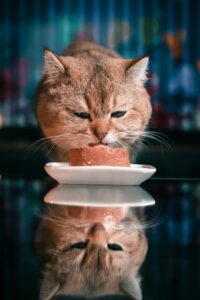Unlocking the Secrets of Cat Food Labels: Essential Insights for Responsible Pet Owners
Understanding and reading cat food labels might seem trivial at first, but it is absolutely vital for ensuring that your cherished feline receives the nutritional balance required for their optimal health and vitality. These labels provide crucial details that extend far beyond the general text found on packaging; they act as a guide to deciphering the quality and composition of your cat’s diet. By becoming familiar with these labels, you empower yourself to make well-informed choices that can significantly improve your cat's well-being and extend their lifespan.
One of the most critical elements of cat food labels is the precise terminology used. Phrases like “complete and balanced” indicate that the product meets the nutritional standards set by the Association of American Feed Control Officials (AAFCO). Understanding these definitions is crucial as it enables you to select foods that provide the essential nutrients your cat requires to thrive. This knowledge empowers you to make choices that bolster your cat's health, ensuring they receive a diet specifically tailored to their unique physiological needs.
As you scrutinize cat food packaging, you will often come across terms such as ‘natural’ or ‘organic’. Although these labels may catch the eye of consumers, they carry different meanings and implications regarding quality. For instance, ‘natural’ typically denotes the absence of artificial flavors or colors, but it does not automatically assure overall quality. On the other hand, ‘organic’ refers to specific production methods that often uphold a higher standard of safety and quality, making it a more desirable choice for health-conscious pet owners who prioritize their cat’s well-being.
The AAFCO plays a pivotal role in establishing nutritional standards within the pet food industry. Their guidelines ensure that products labeled as ‘complete and balanced’ fulfill certain nutritional requirements tailored to various life stages. Grasping these labels is essential for pet owners seeking to make educated decisions about their cat's diet and overall health. By leveraging this knowledge, you can select the most suitable options that cater to your feline’s individual dietary needs.
Developing a thorough understanding of the information presented on your cat’s food label can profoundly influence your ability to make nutritious choices that enhance their health and overall well-being. The insights you gain will enable you to choose high-quality foods that adequately meet your cat's dietary requirements, thereby promoting a longer and healthier life.
 Understanding Cat Food Ingredients: Key Information for Pet Owners
Understanding Cat Food Ingredients: Key Information for Pet Owners
A crucial aspect of interpreting cat food labels involves a meticulous examination of the ingredients list. Ingredients are typically listed in order of weight before cooking, which means that the first few items on the list highlight the primary components of the food. This hierarchy is essential, as it provides valuable insight into what your cat is consuming on a daily basis, allowing you to make better dietary choices.
For cats, who are classified as obligate carnivores, it is vital that the ingredient list prioritizes protein sources. Look for specific protein sources such as chicken, beef, or salmon appearing at the top of the list, rather than vague terms like ‘meat meal’. This clarity reflects a higher quality and more nutritious diet that aligns with your cat's natural dietary preferences and essential needs.
It is equally important to identify and limit certain additives and fillers in your cat's diet. Ingredients such as corn, soy, or wheat gluten may serve to increase the food's volume but offer minimal nutritional benefits for cats. Instead, focus on options that include wholesome grains and vegetables, which can act as healthier alternatives and contribute to a balanced diet that supports your cat's health.
Exercise caution regarding artificial preservatives commonly found in pet foods, such as BHA, BHT, and ethoxyquin. While these substances are frequently added to extend shelf life, they may not represent the healthiest options for your feline friend. Opt for foods that utilize natural preservatives like vitamin E (tocopherols) or vitamin C (ascorbyl palmitate) to maintain the quality and safety of their diet.
If you come across unfamiliar or lengthy ingredient names, take the initiative to research them. Being well-informed about what your cat consumes is the most effective way to ensure that you are making educated choices that contribute positively to their health and longevity.
Evaluating Nutritional Content: Achieving the Right Dietary Balance for Your Cat
Comprehending the Guaranteed Analysis section on cat food labels is vital for gaining insights into the nutrient composition of the food. This section typically outlines the minimum or maximum percentages of crude protein, fat, fiber, and moisture. Achieving the right balance of these nutrients is essential for maintaining your cat’s overall health and well-being.
The protein content is a primary factor to consider when selecting cat food. Cats require high levels of protein to thrive, so it is crucial to ensure that adequate amounts come from animal sources, which provide the essential amino acids necessary for their health. Avoid foods that rely heavily on plant-based proteins, as these often lack the complete range of nutrients that cats need for optimal health and vitality.
Carbohydrate content is another significant factor to consider when evaluating cat food options. While some carbohydrates can be beneficial when included in moderation, they should not dominate the ingredient list, particularly for cats that may be prone to obesity. Aim for foods that prioritize higher protein and lower carbohydrate levels to support a healthy and balanced diet that meets your cat's needs.
Essential nutrients, such as taurine, play a critical role in your cat's health. Taurine is necessary for maintaining heart and eye health, and since cats cannot produce it on their own, it is essential to ensure that your chosen food contains this vital component. Always check the label to confirm that taurine is included, as it is crucial for your cat's long-term well-being.
Be vigilant about potential allergic reactions in cats that may stem from certain food ingredients or imbalances in their diet. Common allergens can vary from cat to cat, so observe your pet closely for any signs of adverse reactions. If necessary, consider exploring hypoallergenic food options that cater to sensitive cats, ensuring their dietary needs are met without triggering any health issues.
 Proven Strategies for Choosing the Best Cat Food for Your Feline Friend
Proven Strategies for Choosing the Best Cat Food for Your Feline Friend
Selecting the best food for your cat involves more than simply picking the product with the most visually appealing packaging. It’s about matching the nutrition with your cat’s unique needs and lifestyle. When making your selection, consider critical factors such as your cat's age, activity level, and any specific health issues they may have that would influence their dietary requirements.
Tailoring the diet to your cat’s lifestyle can greatly affect their health and overall vitality. For instance, an active outdoor cat will likely require more calories and protein compared to a more sedentary indoor companion. Recognizing their daily activities helps guide you in providing a diet that adequately supports their specific energy needs and promotes healthy growth.
Remember that price does not always equate to quality, so it’s vital not to be misled by cost alone. Often, you may find yourself paying a premium for branding rather than actual nutritional benefits. Understanding what the ingredients and nutritional breakdown signify for your cat's health is far more important than the price tag, ensuring you invest wisely in their well-being.
Keep in mind that pet food brands frequently modify their recipes, sometimes subtly and other times quite significantly. Staying updated about these changes ensures that you are always aware of what is being served in your cat's bowl. Regularly checking for updates from brands can help you avoid unexpected dietary shifts that may adversely affect your cat's health and happiness.
Lastly, consulting with your veterinarian can provide personalized insights tailored to your cat's specific health needs. A veterinarian can recommend appropriate food options that cater to dietary restrictions or health concerns, giving you peace of mind that your cat is receiving optimal nutrition for a happy, healthy life.
The Article : How To Interpret Your Cat’s Food Labels Appeared First On Unity Pets.
The Article Interpreting Cat Food Labels: A Quick Guide Was Found On https://limitsofstrategy.com

